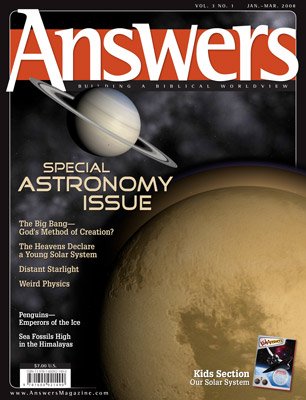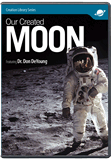Far Out Claims About Astronomy
Christians should uphold the highest standards of excellence in their science, questioning all quirky claims and avoiding hasty conclusions.
This issue of Answers presents a wealth of evidence in support of God’s recent supernatural creation. Of all people, Christians should uphold the highest standards of excellence in their science, questioning all quirky claims and avoiding hasty conclusions, such as the examples described in this article.
Moon Landing Conspiracy
Some people deny that the U.S. Apollo moon landings ever occurred. Instead, they consider the landings part of a grand conspiracy to deceive the Soviets during the space race of the 1960s. This bizarre claim quotes a few details out of context, while hiding mounds of contrary evidence. Its supporters are guilty of the confusion and deception that they ascribe to others.
Mars’s Close Approach to Earth
There is a recurring story that Mars is nearing its closest approach to earth in many centuries. Mars is then predicted to appear as large as the full moon in our night sky. In truth, Mars comes relatively close to the earth every 26 months. Even at its nearest, however, Mars would have to be enlarged nearly 100 times to appear the same size as the full moon.
NASA’s Discovery of the Missing Day
It is an urban legend that NASA computers verified the “long days” recorded in Joshua 10:13 and 2 Kings 20:11. According to this popular story, scientists noticed that today’s positions of the sun and moon were not quite where they belonged, but they can be corrected by making allowance for the biblical events.
This story was never reasonable. Modern astronomers cannot know the exact positions of the sun and moon prior to these biblical events. So it is impossible for computers to calculate changes from such unknown positions.
Other Astronomical Controversies . . .
Too Little Moon Dust
Only a thin layer of dust covers the moon’s surface. However, this does not prove a young age for the moon. Before the Apollo lunar missions, a few scientists had predicted that a yards-thick layer of dust should have settled on the moon over billions of years.
Editor’s Note: During the 1960s and 1970s many creationists adopted the “moon dust” argument based on early calculations by some secular scientists, but more accurate information is now available.
Those predictions got a lot of press, yet further satellite measurements of dust in space indicated a much smaller rate of accumulation than previously assumed. This does not mean the moon is billions of years old; modern scientists cannot know the rate of dust accumulation in the past or the amount of dust originally on the moon. Therefore moon dust cannot be used as an age indicator one way or the other.
The Shrinking Sun
In past years, certain selected data appeared to show a decreasing size for the sun. This suggested that the sun might be powered by gravitational collapse rather than nuclear fusion. Since gravitational collapse is not as efficient as fusion, the sun could not last for billions of years.
There also was an earlier problem with missing neutrinos, which are particles emitted by the solar nuclear fusion process. The neutrino deficit once seemed to support the notion that the sun is shrinking rather than powered entirely by fusion.
However, modern solar telescopes do not detect solar shrinkage. It seems that the original data merely indicated small oscillations or vibrations of the sun. Furthermore, the missing neutrinos now have been accounted for; newer instruments detect precisely the number of neutrinos expected from solar fusion. Although the sun may be undergoing a very small amount of gravity collapse, we can be confident that the sun produces energy by nuclear fusion, not an inward collapse.
Decay of the Speed of Light
Editor’s Note: Some creationists and even secular scientists continue to research the controversial hypothesis that the speed of light can change.
If the speed of light was faster in the past, this might help explain how we could see distant stars in a young universe. Three centuries of data are available, however, and light speed appears to be constant at about 186,000 miles/second (299,300 km/sec). We can speculate about a large-scale change of light speed in the past, but evidence is lacking. In addition, any alteration of light speed would affect several other constants of nature, but evidence of these changes is also lacking.
Conclusion
Guided by the truth of the Bible, Christians should be careful to investigate every claim before jumping to conclusions. As the Apostle Paul said, God’s people should always strive to “approve things that are excellent” (Philippians 1:10).
Answers Magazine
January – March 2008
This collector’s quality issue is a special, extended 112-page issue about astronomy, covering the big bang, black holes, space exploration, and much more!
Browse IssueRecommended Resources

Answers in Genesis is an apologetics ministry, dedicated to helping Christians defend their faith and proclaim the good news of Jesus Christ.
- Customer Service 800.778.3390
- Available Monday–Friday | 9 AM–5 PM ET
- © 2025 Answers in Genesis




